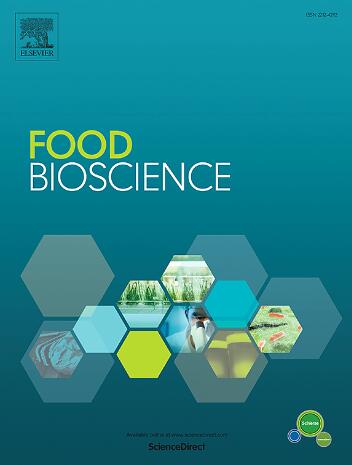Identification of a novel DON dehydrogenase and computational insights into the decisive role of cofactor affinity in DON detoxification
IF 4.8
1区 农林科学
Q1 FOOD SCIENCE & TECHNOLOGY
引用次数: 0
Abstract
Deoxynivalenol (DON) is a pervasive mycotoxin contaminating cereal crops, thereby posing significant risks to both human and animal health. A novel DON dehydrogenase, KvDDH, was identified as an efficient catalyst for degrading DON. The enzyme exhibited optimal activity at 35 °C and pH 6.0, in the presence of preferred cofactor phenazine methosulfate (PMS). Computational approaches integrated AI-driven structural modeling, molecular docking, density functional theory (DFT) calculations, and molecular dynamics (MD) simulation to reveal the affinity between enzyme and cofactors. DFT-based molecular surface electrostatic potential analysis revealed that the nucleophilic sites of PMS, 2,6-dichlorophenolindophenol (DCPIP), and pyrroloquinoline quinone (PQQ) are strategically positioned to accept protons, thereby facilitating protonation. Notably, MD simulations demonstrated that the proton-accepting group of PMS maintains the shortest average distance (5.88 Å) to the catalytic residue Asp306 in KvDDH, accompanied by the lowest binding free energy (ΔGbind = −28.67 kcal/mol) among the cofactors tested. Furthermore, degradation product analysis confirmed the conversion of DON to 3-keto-DON, supporting a catalytic mechanism that involves cyclic regeneration of PMS and DCPIP. Asp306 appears to mediate proton transfer from the C3-hydroxyl group of DON to the cofactors, thereby promoting electron transfer and cofactor regeneration during dehydrogenation. These findings underscore the utility of computational strategies for accurately predicting cofactor-DON dehydrogenase interactions.

鉴定一种新的DON脱氢酶和计算见解的决定性作用的辅因子亲和力在DON解毒
脱氧雪腐镰刀菌醇(DON)是一种普遍存在的真菌毒素,污染谷类作物,从而对人类和动物健康构成重大风险。一种新型的DON脱氢酶KvDDH被确定为降解DON的有效催化剂。该酶在35°C和pH 6.0条件下表现出最佳活性,并有首选辅因子phenazine methosulfate (PMS)存在。计算方法集成了人工智能驱动的结构建模、分子对接、密度泛函理论(DFT)计算和分子动力学(MD)模拟,以揭示酶和辅因子之间的亲和力。基于dft的分子表面静电电位分析表明,PMS、2,6-二氯酚吲哚酚(DCPIP)和吡咯喹啉醌(PQQ)的亲核位点被战略性地定位为接受质子,从而促进质子化。值得注意的是,MD模拟表明,PMS的质子接受基团与KvDDH中催化残基Asp306的平均距离最短(5.88 Å),并伴有最低的结合自由能(ΔGbind =−28.67 kcal/mol)。此外,降解产物分析证实了DON转化为3-酮-DON,支持PMS和DCPIP循环再生的催化机制。Asp306似乎介导质子从DON的c3 -羟基转移到辅助因子,从而促进脱氢过程中的电子转移和辅助因子再生。这些发现强调了精确预测辅因子- don脱氢酶相互作用的计算策略的实用性。
本文章由计算机程序翻译,如有差异,请以英文原文为准。
求助全文
约1分钟内获得全文
求助全文
来源期刊

Food Bioscience
Biochemistry, Genetics and Molecular Biology-Biochemistry
CiteScore
6.40
自引率
5.80%
发文量
671
审稿时长
27 days
期刊介绍:
Food Bioscience is a peer-reviewed journal that aims to provide a forum for recent developments in the field of bio-related food research. The journal focuses on both fundamental and applied research worldwide, with special attention to ethnic and cultural aspects of food bioresearch.
 求助内容:
求助内容: 应助结果提醒方式:
应助结果提醒方式:


